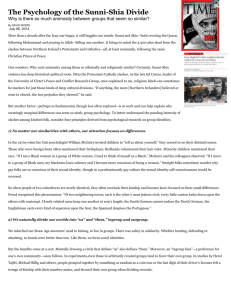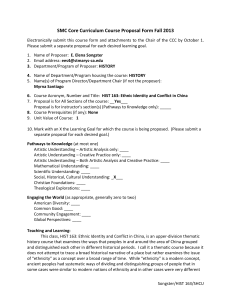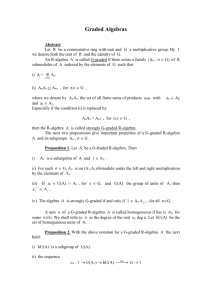Crossed Categorization
advertisement
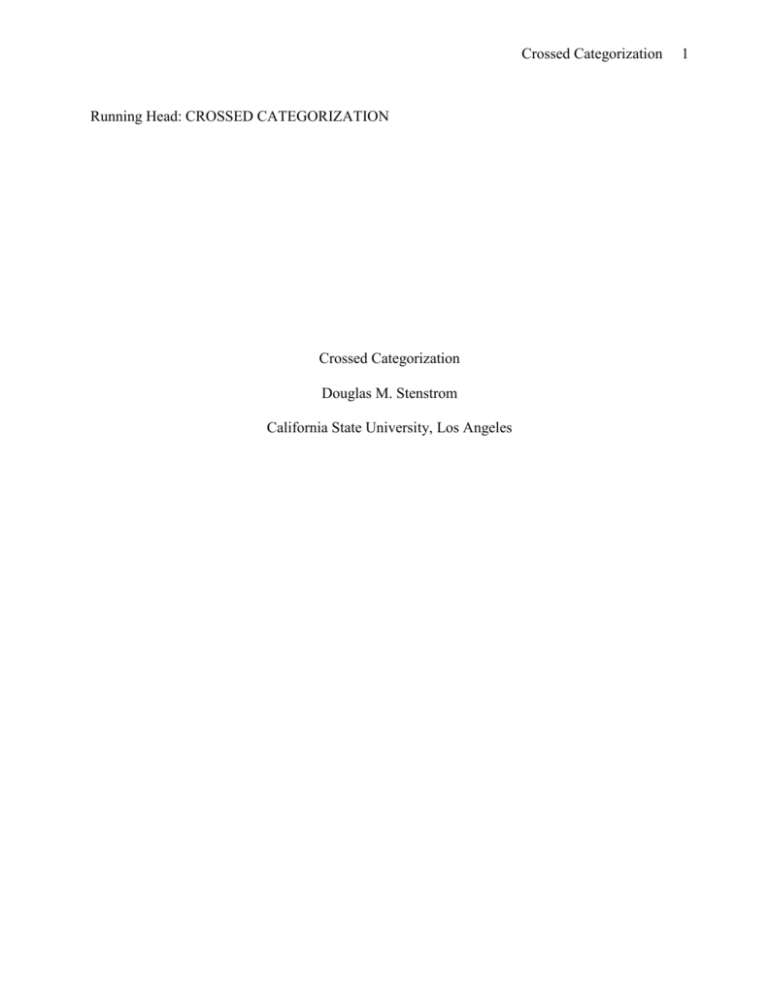
Crossed Categorization Running Head: CROSSED CATEGORIZATION Crossed Categorization Douglas M. Stenstrom California State University, Los Angeles 1 Crossed Categorization 2 Crossed Categorization When we meet someone who differs from us on one dimension of social categorization (outgroup member) but who is similar on another dimension (ingroup member), crossed categorization exists (Crisp & Hewstone, 1999; Urada & Miller, 2000). In the crossed categorization paradigm, orthogonally overlapping two ingroup memberships and two outgroup memberships produces four target groups that participants evaluate: double ingroup (ii), crossed groups (io and oi), and double outgroup (oo) (Migdal, Hewstone, & Mullen, 1998; Miller, Urban, & Vanman, 1998). As an illustration, a participant who is both young and a Democrat is asked to evaluate groups comprised of young Democrats (ii), young Republicans (io), older Democrats (oi), and older Republicans (oo). More recent extensions of the crossed categorization research paradigm have investigated multiple overlapping categories beyond the traditional two-group model (Urada, Stenstrom, & Miller, 2006). In these instances, participants are asked to evaluate people with incrementally more overlapping category memberships, such as oi, oii, oiii, oiiii, and so forth (Crisp, Hewstone, and Rubin, 2001). The purpose behind crossed categorization is to reduce real-world bias and discrimination. History is replete with instances where people are distinctively categorized on the basis of their race, ethnicity, citizenship, political affiliation, social status, religion, gender, sexual orientation, etc (Urban & Miller, 1998). The result of categorizing people into ingroups and outgroups is group-based animosity, hostility, and violence. Research into social identity has consistently shown that merely categorizing people into "us" vs. "them" or "we" vs. "they" is sufficient to create intergroup bias (Brewer & Miller, 1984), and sometimes even extends to more severe forms of intergroup hostilities and violence as evidenced by real-world identity-based conflicts between nations, ethnic, religious, and political groups (Urada et al., 2006). Extreme examples include Crossed Categorization 3 conflicts with long and intense histories such as Irish Protestants and Catholics, Israeli Palestinians and Jews, and Rwandan Hutus (Urada et al., 2006). However, the same type of ingroup-outgroup categorization also impacts more moderate intergroup strife like Republican-Democrat, Pro LifePro Choice, Yankee-Dodgers, and so forth (Crisp et al., 2001). Crossing category memberships within the crossed categorization research paradigm (CC paradigm) has been proposed as a technique for reducing these types of intergroup biases in realworld settings where individuals belong to many different overlapping social categories (Ensari & Miller, 1998). When two people meet, a number of distinct group memberships, such as age, ethnic background, and gender, can become instantly salient even before either person has had a chance to speak. Religious jewelry, dress, and speech accent provide additional immediate cues for category identities (Ensari & Miller, 1998). In other words, people instantly identify multiple overlapping category memberships. Making crossed categorizations salient has been advocated as a potentially effective tool to decrease this intergroup bias by decreasing either category differentiation – a cognitive component, or group identification – a motivational component (Urada et al., 2006). Unlike the targets with convergent group memberships (ii and oo), crossed group membership targets (io and oi) contain conflicting cues about the individual’s group identity (Crisp et al., 2001). As an example, a young Democratic participant may feel less bias for a group comprised of Republicans who are also young like the participant because shared membership on one category dimension (young) is in conflict with, and cancels out, the distinctiveness of the other category dimension (Republicans) (Urada et al., 2006). In this way, sharing an in-group membership with an out-group member (crossing categories) can reduce both the differentiation between the groups (cognitive component) Crossed Categorization 4 and the negative feelings toward the group member (affective or motivational component) (Migdal et al., 1998). Given overlapping ingroups and outgroups in the traditional two-group model (ii, io, oi, oo), research has identified six distinct patterns of evaluation (Miller et al., 1998). The most common pattern is the additivity pattern (ii > io = oi > oo) wherein double ingroups are evaluated most positively, double outgroups are evaluated most negatively, and mixed groups are somewhere in between the two extremes (Crisp and Hewstone, 1999). In other words, the participant positively evaluates any target with a single ingroup membership higher than a target without an ingroup membership; and positively evaluates a target with two ingroup memberships higher than a target with one ingroup membership. With respect to the goal of reducing societal conflict, however, the most desirable pattern is the equivalence pattern wherein all four target groups are evaluated equally (ii = io = oi = oo; Mullen, et al., 2001). In this pattern, the outgroup targets (e.g., oo, oi, io) are rated equivalent to the true ingroup member (ii), and therefore all bias is reduced toward the outgroup targets compared to ingroup targets. Example - Research As a concrete example of crossed categorization research, Urada et al., (2006) investigated processing of ingroup and outgroup information with stimuli that are more complex than those used in previous crossed categorization studies. The research question was, given the existence of a dominant outgroup membership (O), would crossing the outgroup with multiple less dominant ingroup memberships (Oi, Oii, Oiii) result in bias reduction. The hypothesis was that incrementally adding more ingroup memberships would result in a “threshold” based evaluation pattern in which targets would shift from “outgroup like” to “ingroup like” after a certain threshold of two ingroup memberships (O=Oi<Oii=Oiii=I). In other words, minor ingroup memberships could eventually Crossed Categorization 5 cancel out or counteract the dominant outgroup membership. The method of the research study involved participants indicating the groups to which they belonged, and then evaluating potential partners for an upcoming problem-solving task. The operationalization of “crossed categorization” within the method was manipulating the group memberships of the potential partners for the problem solving task. Based upon the participants’ answers to the initial survey about the groups to which they belonged, the experimenters choose group memberships for the potential partners that fit the intended crossed categorization groups of O, Oi, Oii, Oiii. If the participant indicated a strong political group membership (Democrat), for example, and less important memberships with age (young), citizenship (US), and martial status (single), then the Oiii target would be a Republican who is old, not a US citizen, and married. The dependent measure was asking participants how much the participants wished to be partners with each described target. The result of the research study confirmed the hypothesis that the addition of two non-dominant ingroup memberships was sufficient to counteract the dominant ingroup membership and result in the evaluation ratings equivalent to the true ingroup member (O=Oi<Oii=Oiii=I). The implication of the research is that interventions could be developed that make salient or even create multiple ingroup memberships over a sufficient duration to allow positive personalized interaction to occur. Example - Real-Life In a recent news story from CNN entitled “Trapped between worlds, some Latina teens consider suicide” (Yager, 2009), there is an astonishing report from the Centers for Disease Control (CDC) that one out of every seven Latina teens attempts suicide. Why? The article discusses a few explanations including the possibility that Latina teens face a conflict between two cultures – the Latino heritage of their parents, and the American culture in which they currently live. The conflict creates feelings of confusion, frustration, and being trapped between the peer- Crossed Categorization 6 group pressure to fit within the American culture and the family-group pressure to fit within the Latino culture. The article reports that one primary explanation for the suicidal behavior is a disconnect between the mothers and daughters, with the daughters feeling overwhelming pressure from their parents to maintain the Latina heritage. The research on crossed categorization may help explain the conflict, and may also explain how to reduce the conflict. Crossed categorization, for example, stems from a desire to try to reduce real-world bias and discrimination that exists when people categorize each other along ingroup-outgroup lines. Latina teens are faced with that ingroup-outgroup categorization on a daily basis, and more importantly, they are faced with that categorization from both cultures. One way to potentially reduce the conflict is through using the principles of crossed categorization. Instead of maintaining the perception along ingroup-outgroup lines, Latina teens which are currently being perceived as cultural outgroup members by their mothers could create shared connections along other lines within the family, thereby creating crossed groups (oi). Alternatively, the Latino teens could try changing how they are perceived to fit each situation, such that within the family they focus on the Latina heritage, thereby priming the shared ingroup memberships. Bicultural individuals, for example, are routinely faced with having to choose between their multiple cultural identities. At any given moment, their focus or perception of themselves and others may be influenced by the combination of group memberships to which they belong and the people or situations in which they are presently surrounded. Consistent with the theorizing behind crossed categorization, the article reported that reducing the perceived disconnect between mothers and daughters was an effective intervention for reducing the incidents of Latina teen suicide. Crossed Categorization 7 References Brewer, M.B., & Miller, N. (1984). Beyond the contact hypothesis: Theoretical perspectives on desegregation. In N.M. & M.B. Brewer (Eds.), Groups in Contact: The Psychology of Desegregation (pp 281-302). Orlando, FL: Academic Press. Crisp, R. J. & Hewstone, M. (1999). Differential evaluation of crossed category groups: Patterns, processes, and reducing intergroup bias. Group Processes and Intergroup Relations, 2, 307-333. Crisp, R. J., Hewstone, M., Rubin, M. (2001). Does multiple categorization reduce intergroup bias? Personality and Social Psychology Bulletin, 27, 76-89. Ensari, N., & Miller, N. (1998). Effect of affective reactions by an out-group on preferences for crossed categorization discussion partners. Journal of Personality & Social Psychology, 75(6) 1503-1527. Migdal, M.J., Hewstone, M., & Mullen, B.M. (1998). The effects of crossed categorization on intergroup evaluations: A meta-analysis. British Journal of Social Psychology, 37, 303324. Miller, N., Urban, L. M., & Vanman, E. J. (1998). A theoretical analysis of crossed categorization effects. In C. Sedikides, & J. Schopler (Eds.), Intergroup cognition and intergroup behavior (pp. 393-420). Mahway, NJ: Earlbaum. Mullen, B., Migdal, M. J., & Hewstone, M. (2001). Crossed categorization versus simple categorization and intergroup evaluations: A meta-analysis. European Journal of Social Psychology, 31, 721-736. Urada, D.I., & Miller, N. (2000). The Impact of Positive Affect on Crossed Categorization Effects. Journal of Personality and Social Psychology, 78(3), 417-433. Crossed Categorization 8 Urada, D. I., & Stenstrom, D. M., & Miller, N. (2006). Crossed categorization beyond the two group paradigm. Journal of Personality and Social Psychology, 92, 649-664. Urban, L. M., & Miller, N. (1998). A theoretical analysis of crossed categorization effects: A meta-analysis. Journal of Personality and Social Psychology, 74(4), 894-908. Yager, C. (2009). Trapped between worlds, some Latina teens consider suicide. Retrieved October 24, 2009 from cnn.com: http://www.cnn.com/2009/LIVING/10/24/lia.latina.suicides/
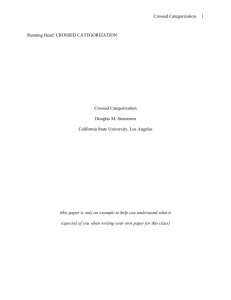


![[Share-My-Toys Membership] Marketing Plan](http://s2.studylib.net/store/data/005475303_1-5c5fcecf250fc9c92c1a18cc8f242409-300x300.png)
